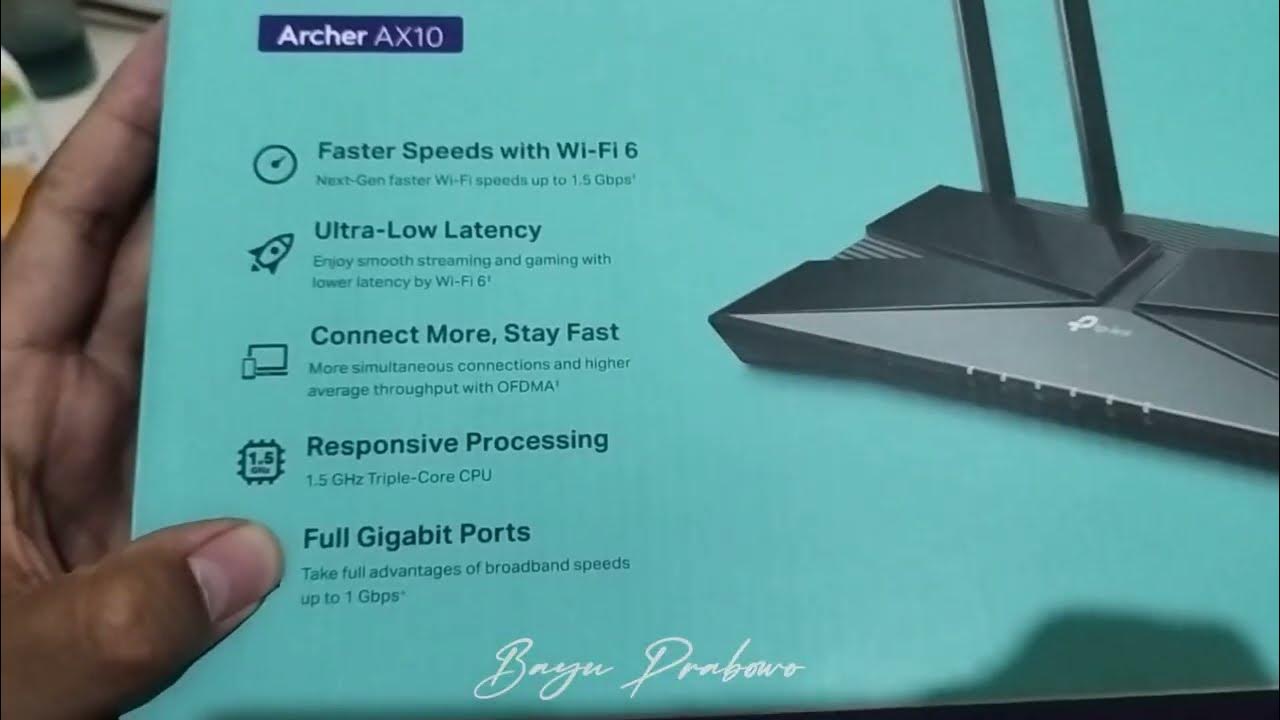REVIEW DAN SETUP AWAL ROUTER TP LINK AX1500 WIFI 6 ARCHER AX12 [PART 2]
Summary
TLDRIn this video, the speaker reviews the TP-Link AX 1500 (AX12) Wi-Fi 6 router, discussing the process of troubleshooting its connection speeds. Initially, the router struggled with speeds under 100 Mbps due to connecting to the 2.4 GHz band. After restarting the router, it switched to the 5 GHz band, improving the speed to 109-120 Mbps. The speaker demonstrates how the router automatically selects between 2.4 GHz and 5 GHz based on device capabilities, providing a more stable connection. The review highlights the router’s strong performance, especially for environments with multiple devices.
Takeaways
- 😀 The video discusses a review of the TP-Link AX1500 router, specifically focusing on its Wi-Fi 6 features.
- 😀 The router has the AX12 model and allows for easy login via the admin interface at 192.168.0.1.
- 😀 The reviewer initially faced issues with the connection speed, which was below 100 Mbps due to the router defaulting to a 2.4 GHz connection instead of 5 GHz.
- 😀 After restarting the router, the connection automatically switched to 5 GHz, improving the speed significantly.
- 😀 The Smart Connect feature of the router allows for automatic switching between 2.4 GHz and 5 GHz bands without the need for manual adjustment.
- 😀 The test results after the router restarted showed speeds of up to 150 Mbps, with a stable range of 109-111 Mbps for download and around 31 Mbps for upload.
- 😀 The reviewer compared the router's performance with another device, finding similar results despite the difference in router models.
- 😀 The router can handle multiple devices at once, making it ideal for home or office use where many devices are connected simultaneously.
- 😀 The connection speed, when the router was using 2.4 GHz, was found to be slower (around 50 Mbps), but the 5 GHz connection showed much better performance after a restart.
- 😀 The review emphasizes the importance of restarting the router if the connection doesn't automatically switch to the 5 GHz band.
- 😀 The video concludes by encouraging viewers to like and subscribe for more reviews and tips, with an invitation to watch future content on the channel.
Q & A
What is the model of the router being reviewed in the video?
-The router being reviewed is the TP-Link AX1500, specifically the ARSER AX12 model.
What was the issue with the internet speed in the previous video?
-In the previous video, the internet speed was not reaching 100 Mbps, and it was discovered that the connection was still using the 2.4 GHz frequency instead of the 5 GHz frequency.
What setting was used to manage the 2.4 GHz and 5 GHz frequencies?
-The 'Smart Connect' feature was enabled, which automatically switches between 2.4 GHz and 5 GHz frequencies without showing separate names for each band.
How did the user resolve the issue with the 2.4 GHz connection?
-The user restarted the router, which allowed the connection to switch to the 5 GHz frequency, improving the speed.
What was the speed test result after the router was restarted?
-After restarting the router, the internet speed improved, with download speeds ranging between 109 to 120 Mbps and upload speeds around 31.64 Mbps.
How did the router's speed compare to the 'Indie Home' router?
-The TP-Link AX1500 router showed stable speeds around 109 Mbps, which was comparable to the 'Indie Home' router's speeds, though the 'Indie Home' router's speeds were sometimes unstable, fluctuating between 80 to 90 Mbps.
What is the significance of the network map feature in the router settings?
-The network map feature allows users to see which devices are connected to the router and to check whether the devices are using the 2.4 GHz or 5 GHz frequency.
How does the router handle devices that support only 2.4 GHz?
-Devices that only support the 2.4 GHz frequency will automatically connect to the 2.4 GHz band, even when Smart Connect is enabled.
What troubleshooting step did the user take to resolve the connection issue?
-The user restarted the router to fix the issue, which allowed the router to automatically connect to the 5 GHz band, thus improving the connection speed.
What was the speed of the connection before the router was restarted?
-Before the restart, the connection speed was around 50 Mbps, which was likely due to the device being connected to the 2.4 GHz band instead of the 5 GHz band.
Outlines

This section is available to paid users only. Please upgrade to access this part.
Upgrade NowMindmap

This section is available to paid users only. Please upgrade to access this part.
Upgrade NowKeywords

This section is available to paid users only. Please upgrade to access this part.
Upgrade NowHighlights

This section is available to paid users only. Please upgrade to access this part.
Upgrade NowTranscripts

This section is available to paid users only. Please upgrade to access this part.
Upgrade NowBrowse More Related Video

REVIEW DAN SETUP AWAL ROUTER TP-LINK AX1500 WIFI 6 ARCHER AX12 [PART 1]

CARA SETTING DAN PASANG WIFI ROUTER TP LINK AX1500

Cara Setting TP Link WR840N Pakai Mode Range Extender ( Memperluas Wifi ) - Tutorial Pemula

Cara Setting ( Untuk Pemula ) - Router TP Link WR840N Pakai Mode Router ( Jadi Client Jaringan )

Mudahnya Instalasi Jaringan Nirkabel (Tanpa Kabel) Menggunakan Router TP-LINK!🌐🔧

8 Best PCIe Wi-Fi Cards 2025 | Top 8 PCIe Wireless Network Adapters 2025
5.0 / 5 (0 votes)